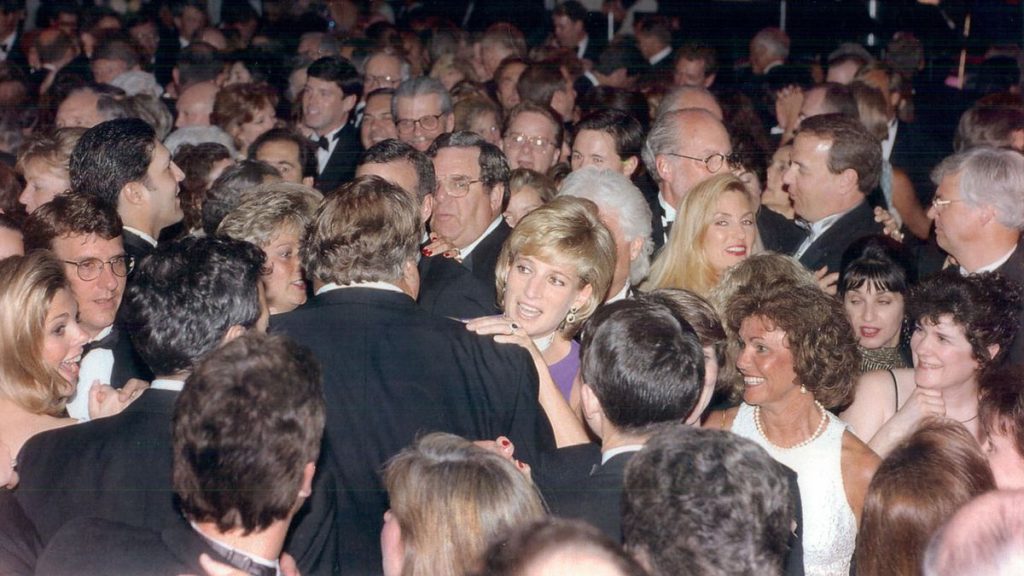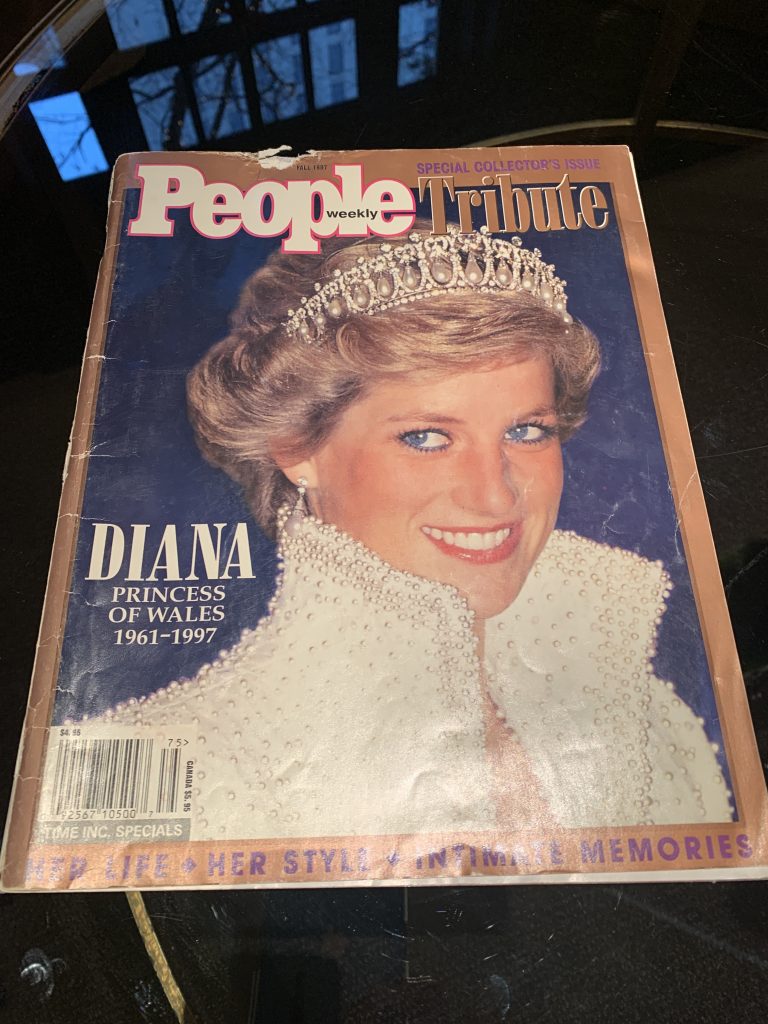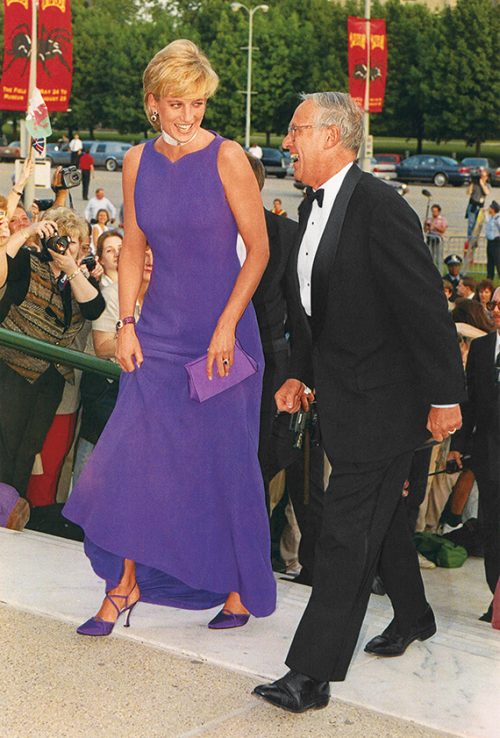BY CORDELIA MESEROW
It had been well over a century since the Great Fire left the city in ashes in 1871. But in 1996, Chicago was yet again set ablaze, not by Mrs. O’Leary’s cow (as legend maintains), but by a princess: Diana, Princess of Wales.

Princess Diana arrives at The Drake Hotel with manager, Martin Lawrence. Image courtesy of The Drake.
Princess Diana arrived in Chicago on June 4, 1996 for a three-day stay organized by Northwestern University. Henry Bienen, the President of Northwestern at the time, spearheaded the visit, with help from Landon Jones, the-then editor-in-chief of People Magazine. Diana was a patron of the Royal Marsden Hospital, a specialty cancer center in London, and the trip focused on fundraising for Royal Marsden, in conjunction with Northwestern’s own cancer research efforts.
By the middle of 1996, Diana had already been formally separated from Prince Charles, and her divorce was to be finalized within months. A trip to the United States was an excellent public relations opportunity for the princess, as she relaunched herself into society as a single woman. Former Northwestern President Henry Bienen said in a 2016 article in The Chicago Tribune: “‘I don’t think she wanted another New York visit,’ but somewhere in ‘the center of the country.’” Diana had already been well-received in New York City during her marriage. A trip to America’s midwestern heartland offered Diana the chance to expand her reach and generate awareness for her charitable causes beyond the coasts. With an elite research university, a large public hospital, and a significant museum gala, Chicago was an ideal city in which to position Diana for her next chapter — a chapter that proved to be tragically brief.

Princess Diana on the cover of “People” magazine’s June 17, 1996 issue, which heralded her trip to Chicago. Image courtesy of Amazon.
Fresh from her British Airways flight, Diana went straight to Northwestern’s Evanston campus to tour the school’s sculpture garden and attend an intimate reception at President Bienen’s home. Crowds in the hundreds greeted Diana upon her arrival in the humble Chicago suburb. She wore a crisp mint green suit and was driven in a black Rolls-Royce limousine. (The car is now exhibited at a museum outside of the city at the Volo Auto Museum). Local Evanston residents and hordes of college students were there to partake in the action, with a level of excitement for a British native not seen since the Beatles arrived state-side to appear on the Ed Sullivan Show in 1964.

A clipping from The Associated Press’s coverage on Diana’s arrival at Northwestern’s Evanston campus. Image courtesy of The Chicago Tribune.
Diana had a packed itinerary for her three-day visit. In addition to the Northwestern Evanston campus visit, the Princess would also give a speech at the university’s downtown law school campus, tour Cook County Hospital, and headline two benefits: a luncheon at The Drake Hotel and a landmark black-tie gala at The Field Museum. Classic Chicago’s own Judy Bross was lucky enough to be in attendance when Princess Diana gave her speech on breast cancer research at Northwestern’s downtown campus and had the following memories of her visit:
“Members of the Women’s Board of Northwestern Memorial Hospital were invited to attend a talk given by Princess Diana in one of the hospital’s large auditoriums on Chicago Avenue. We were told to get there early to sit down front. I remember being on the same side of the auditorium where her podium was. She was dressed in a pale blue suit, was very tall and smiled frequently. She spoke with beautiful diction and obvious sincerity as she talked of compassionate care and her own humanitarian commitments, always about what others had accomplished not focusing on herself. It was not at all a “canned” speak, but one she obviously meant. What most impressed me was that she then went to the Hospice floor where she allowed no press or photographers to join her. I was a volunteer at the time there and heard afterwards from the unit’s chaplain that she spent over an hour and visited with each patient there. That was a time when we had many young patients suffering from HIV-AIDs on the floor, many of them quite young whom their families refused to visit, both men and women. She talked with everyone in her tender way that made everyone always love her. I am sure she did this so frequently in her life, not as a photo opportunity, but her graciousness to both patients and staff that day at the Hospice unit will always be a memorial to her kindness.”

Diana at the Northwestern Memorial Hospital symposium where she would give a speech. Image courtesy of The Chicago Tribune.
Judy keenly picked up on the genuine nature of Diana’s words. It was later noted that the Princess composed her speech herself, a rare occurrence for a public figure of her standing. How lucky Judy and the other members of the Women’s Board are to have been able to witness such a beautiful and inspiring talk from the Princess and to have glimpsed the impact of Diana’s presence in person. Chicago’s own Renée Crown, who was instrumental in organizing Diana’s visit, also remarked on Diana’s incredible ability to delight and inspire the public, especially in the midst of a packed schedule. In a 1997 issue of People magazine after Diana’s death, Crown recalled asking the Princess how she did it – and while Diana admitted that despite that she was “so tired, I could put my head down on the table and fall asleep,” it was “commitment and duty” that motivated her.

Diana arrives at The Field Museum in a purple Versace dress escorted by Northwestern President Henry Bienen. Image courtesy of Northwestern University.
The Princess’s commitment proved to be unwavering throughout her trip to Chicago, and she shined at an evening gala at The Field Museum during her visit. A sold-out crowd of 1,300 guests descended upon Chicago’s museum campus on a warm June night to be in the presence of the most famous woman in the world. Tony Bennett was flown in to sing for the occasion. The singer noted it was one of the few times in his career that he waived his fee for performing. Northwestern President, Henry Bienen, escorted the Princess to the event, where she wore a deep purple floor-length gown designed by her dear friend Gianni Versace. Many noted that Diana’s dress was Northwestern’s signature purple. Bienen recalled to The Chicago Tribune in 2016 asking Diana if she chose the dress for that reason: “‘I asked her, … ‘Did you wear purple because of Northwestern, or because of royal purple?’ She just laughed. She never answered.” Royal watchers well know the scrutiny given to any princess’s fashion choice, but Diana was sly enough to never reveal the purpose of her dress that night and leave it to the audience’s imagination.

Diana dances in the crowds of guests at The Field Museum gala. Image courtesy of The Chicago Tribune.
Let us not forget it was the 1990s, and in that decade, Chicago was ruled by the House of Jordan, not the House of Windsor. (Classic Chicago Magazine detailed Jordan’s influence in an article written this past June by yours truly). One of the Northwestern revelers who greeted Princess Diana in Evanston held a sign that read: “We love you like we love da Bulls!”, the highest praise anyone could receive from a Chicago resident at the time. The second night of Diana’s visit brought a conflict between Chicago’s “King” Jordan and Princess Di: the night of the benefit gala at The Field Museum coincided with game one of the NBA finals against the Seattle SuperSonics at the United Center. Deloris Jordan, Michael’s mother, was supposed to attend the gala at The Field Museum but only stayed for a short time before jetting off to the city’s west side to watch her son beat Seattle. When Ms. Jordan met the Princess, she presented Diana with a bag of Bulls’ gear to bring home for her sons. Even though the Bulls won against the SuperSonics that night, former Illinois Governor Jim Edgar conceded to The Associated Press that Diana was the real victor. She was “the only one who could knock Michael Jordan off the front page” and recalled saying to the Princess that she should tell her sons that she was the one who made it on the Tribune’s front page over Michael the following day.

The fall 1997 collector’s issue of People Magazine issued after Diana’s death.
Diana has always been a presence in my life, yet it is only when I began to write this article that I realized it. Squeezed among the Latin School of Chicago magnets on the hood of the stove in the apartment where I grew up is a magnet of Princess Diana, Queen of Hearts, wearing the famous “revenge” dress. On the shelf in my childhood bedroom is an early copy of her infamous 1992 Andrew Morton biography. I have even kept the memorial copy of People magazine that was issued in the fall of 1997 after her death. But my most enduring memory of Diana is when my mother took me to see the princess as she departed The Drake Hotel during her Chicago visit. We walked down to Walton Street just off Michigan Avenue and stood in front of the Palmolive building to see Diana leaving The Drake to get into her car. She emerged in that mint green skirt suit into her chauffeured Rolls-Royce with her shy sideways smile – the crowd was ecstatic. Diana rolled down the window and waved to the crowds as her car continued slowly west on Walton Street. I did not know it then, but it was a moment I would never forget and one for which I would always be grateful to my mother for ensuring I witnessed. After Diana had driven away, my mother and I walked to Goudy Park, where I told my friends that I had just seen a real-life princess. They scarcely believed me then, but maybe now they just might!

A memorial Princess Diana magnet I have at home.

Princess Diana exits The Drake Hotel. My mother and I are somewhere in the crowd across the street from Diana on Walton Street. Image courtesy of The Chicago Tribune.
The Drake Hotel continues to honor Diana and her 1996 visit. The Presidential Suite where she stayed has been rechristened the “Princess Diana Suite.” Guests can even indulge in the new “Crowning a Lady” package, which allows guests of the Suite to experience it just as Diana did when she was there. The package includes a stationary bike in the room, the Princess’s favorite mineral water, a bottle of perfume, a bouquet of her favorite flowers, among other items. The package was launched this November, with the recent royal buzz surrounding season four of Netflix’s The Crown. In honor of the hotel’s 100th anniversary this month, the Drake launched a contest for a prized night in the “Diana” suite. The hotel’s general manager, Damien McArdle, remarked in an article on the Drake’s 100th anniversary in yesterday’s Chicago Tribune that Diana was “humble…She was very modest, very friendly, very engaging and a very warm person to the team, from the doormen to room service, to the room attendants.” McArdle’s words are a fitting description of the woman who was often known as “the people’s” princess.

The former Presidential Suite at The Drake Hotel, now renamed the Princess Diana Suite. Image courtesy of The Drake.
By the end of August, the following year after her visit to Chicago, Diana was killed in a fatal car crash in Paris on the Pont de l’Alma. I studied abroad in Paris in 2012 and lived close to the site where the Queen of Hearts died. I saw the Flame of Liberty statue on the renamed “Place Diana” every day when I walked to classes, and every day there were bouquets of flowers on the monument that became a tribute to Diana’s memory – fifteen years later and the wounds of Diana’s death remained as fresh as the cut roses lying on the plaque honoring her near the Seine.

The Flame of Liberty Statue on the Pont de l’Alma in Paris, where Diana died in a car accident in 1997. Image courtesy of The Telegraph UK.
Elton John sang that Princess Diana was “England’s Rose” in his and Bernie Taupin’s 1997 re-write of, “Candle in the Wind,” which the pair recomposed and John performed at Diana’s funeral. But Diana was not just a rose to England. She blew the Windy City away in 1996 and delighted cities and people around the world with her warm presence. Diana altered the definition about what royalty could be. She touched hearts because she opened hers and that legacy can never be forgotten. So, twenty-four years after her visit, Chicago bids adieu to you, dear Princess. Your candle continues to shine ever-bright.

Elton John performs a revised “Candle in the Wind” at Princess Diana’s funeral at Westminster Abbey in September 1997. Image courtesy of Associated Press.







